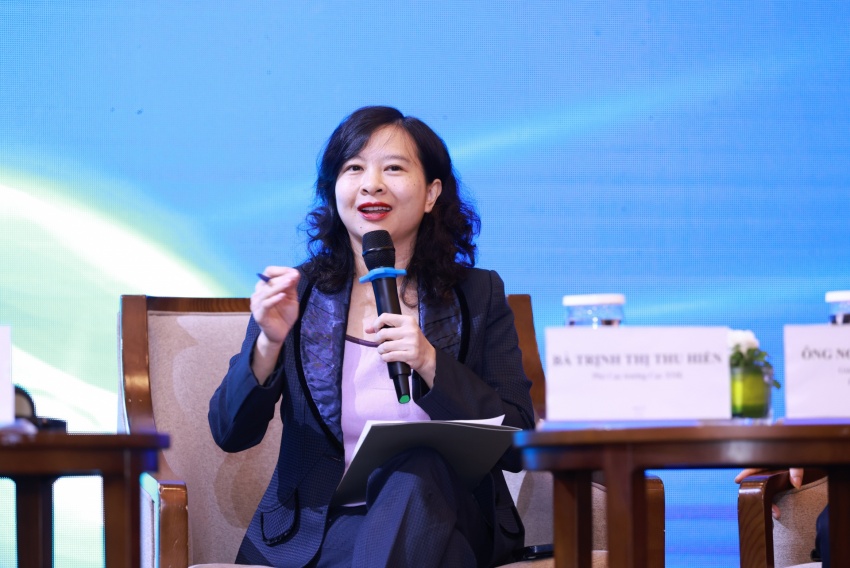At the eleventh MB Economic Insights Forum on November 7 in Hanoi, nearly 500 import-export enterprises joined leading domestic and international economic experts to examine the global trade landscape and discuss proactive strategies for sustaining robust growth in 2026.
Many export-oriented businesses expressed keen interest in the progress of Vietnam-US trade negotiations, particularly regarding tariff commitments and rules of origin for goods.
Trinh Thi Thu Hien, deputy director of the Agency of Foreign Trade under the Ministry of Industry and Trade and member of the Vietnam-US trade negotiation team, emphasised that what businesses need to focus on is not just the tariff rate but the ability to comply with rules of origin to fully benefit from preferential tariffs.
“Even if the import duty is zero, if the goods do not meet the rules of origin, the preferential treatment becomes meaningless,” she said. “Tariff rates may range from 0 to 20 per cent depending on the product and negotiation stage, but rules of origin are predictable and can be prepared for in advance.”
The textiles sector illustrates how rules of origin differ across free trade agreements. For the EU market, the rule “from fabric onward” requires that weaving, finishing, and garment production all take place within member countries. In contrast, under the Comprehensive and Progressive Agreement for Trans-Pacific Partnership, the stricter “from yarn onward” rule requires spinning, weaving, and garment production within the bloc.
“For processed agricultural products, rules of origin can be more complex,” stated Hien, citing chocolate as an example. Cocoa can be imported from Africa, but if roasting, grinding, blending, and production occurs in Belgium or Switzerland, the final product is considered to originate from the latter countries.
“The key is that goods must undergo a substantial transformation in use and nature compared with input materials. When this transformation happens in Vietnam, the product is considered of Vietnamese origin,” she explained.
 |
| Trinh Thi Thu Hien, deputy director of the Agency of Foreign Trade under the Ministry of Industry |
Likewise, in industrial goods, each product group has distinct rules of origin. Footwear differs from textiles, which differ from electronic components or machinery.
“However, the guiding principle remains that Vietnam must be the location where the essential transformation occurs for goods to qualify as Vietnamese origin,” said Hien. “Enterprises need to master these regulations to proactively plan production and business operations. Ensuring origin status gives firms the advantage of fully leveraging tariff benefits, regardless of the specific negotiated rates.”
Building on this perspective, Pham Nhu Anh, CEO of MB, highlighted the bank's proactive approach to forecasting economic fluctuations, sector trends, and global policies while designing tailored solutions and products to help enterprises seize opportunities, mitigate risks, and achieve sustainable growth in 2026.
“With this foresight, businesses can be prepared for potential risks while capitalising on opportunities to grow stronger next year,” he added. “Based on such analysis, MB develops policies and product packages tailored to each sector, helping clients to seize opportunities and manage risks effectively.”
He further elaborated that in 2025, MB had assisted import-export enterprises in navigating geopolitical tensions and US economic policy shifts.
“We provided foreign exchange support and offered the most competitive credit packages for businesses facing difficulties. MB also supported clients in exploring new markets beyond traditional ones, leveraging our representative offices in Russia and Laos to directly facilitate import-export operations,” he said.
 |
| Pham Nhu Anh, CEO of MB |
"Thanks to these measures, particularly risk hedging products against exchange rate fluctuations, businesses were shielded from major shocks. As we have seen, domestic exchange rates remain relatively stable compared with other countries," he added.
He emphasised that import-export enterprises are a priority for both the government and banks, giving Vietnam's export strengths.
"Our products not only offer better credit terms but are also designed based on actual customer behaviour. The goal is to ensure that import-export businesses experience optimal banking services, saving both costs and time," he stated.
“The foundation of this support lies in MB's core retail-focused strategy. Annually, we allocate about 50 to 60 per cent of credit limits to individual clients and SMEs, while the remaining 40 to 45 per cent targets large manufacturing enterprises, including import-export firms,” he added.
From a macro perspective, Sacha Dray, economist at the World Bank in Vietnam, shared that Vietnam faces significant exposure to the tariff environment, having once been the third-largest trading partner with the US, secondary effects from these tariffs could begin impacting Vietnam in 2026.
"At the same time, some initial uncertainties have been mitigated by the wave of implemented trade agreements. However, we see three key areas for Vietnam. The first is market diversification. The US remains a major market, accounting for about one-third of exports and 26 per cent of GDP, yet Vietnam has an extensive network of free trade agreements covering over 90 per cent of global output," he added. “This provides opportunities to further leverage markets such as the EU and Asia, particularly emerging economies with a growing middle class.”
 |
| Sacha Dray, economist at the World Bank in Vietnam |
Dray emphasised the importance of diversifying export products as Vietnam's export basket has evolved from commodity-driven goods to higher value-added products like electronics.
“The services sector still faces broad non-tariff restrictions, but liberalising these areas could create a second growth wave less exposed to direct trade instability,” he added.
He concluded that despite global trade uncertainties, Vietnam can strengthen competitiveness and integrate further into global value chains by focusing on market diversification, product diversification, and increasing domestic value addition.
“The domestic value-added share of exports is currently about half, and only 18 per cent of domestic firms are linked to global value chains. Improving connections between local suppliers and foreign companies, developing capacity-building programmes, and creating industrial clusters can enhance domestic participation and optimise value creation,” he said.















































